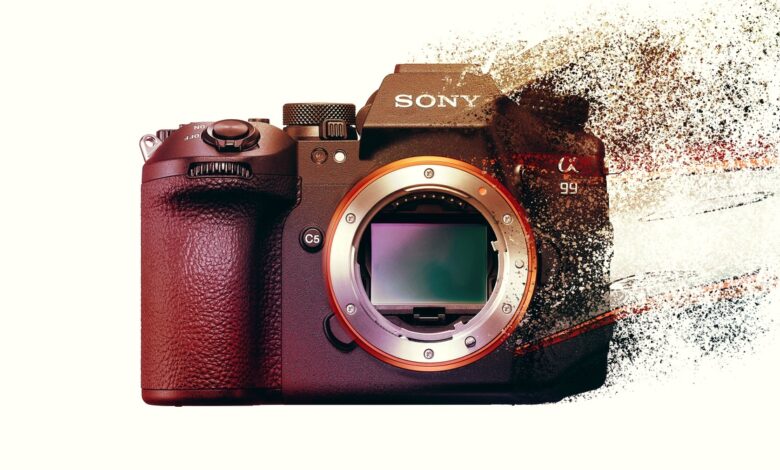How Sony Broke the Canon and Nikon Stalemate

Sony is rapidly rising as a leading camera manufacturer. This article explores how their innovative E mount system and bold approach to features have challenged the Canon and Nikon’s duopoly in the photography industry.
The A Mount Experiment

When Sony introduced the A-mount system in the early 2000s, it was more of a tentative step into the DSLR market rather than a groundbreaking entrance. The market, firmly in the grips of Canon and Nikon, didn’t exactly hold its breath for Sony’s foray into this territory. With the A mount, compatible with a variety of lenses, Sony was testing the waters in the professional and enthusiast photography sectors, but without the fanfare of great expectations.
The A mount’s centrepiece was the Single-Lens Translucent (SLT) technology. This was a departure from the conventional DSLR mirror setup, employing a fixed translucent mirror that promised faster shooting and smoother autofocus in videos. On paper, this was an interesting innovation, but in the grand scheme of things, it wasn’t a game-changer.
The reality was that the A-mount system didn’t make much of a splash. The SLT technology’s light loss issue was a significant misstep, undermining the camera’s performance in low-light scenarios – a critical factor for any serious DSLR user. While Sony is known for pushing the envelope, the A-mount didn’t quite hit the mark. It lacked the disruptive impact necessary to draw photographers away from the established leaders.
In hindsight, the A-mount system was not a resounding success. It struggled to carve out a significant niche in a market dominated by more established brands. Sony’s venture into the DSLR market with the A-mount was an important learning experience, though. It highlighted the challenge of entering a market with deeply entrenched leaders and the importance of aligning innovation with the core needs of users. The A-mount story is a modest chapter in Sony’s history, one that shows a more cautious approach to innovation, without the dramatic flair of transformative success.
Sony a7: Pioneering and Problematic
In 2013, Sony released the a7 and its E-mount system, which was the first ever modern full-frame mirrorless camera to hit the market. Honestly, this wasn’t as big of a deal as it might sound. Mirrorless cameras had been around for a while, The Leica M series can be considered mirroless cameras and even some medium format technical cameras could be described as mirrorless too. And if we’re talking modern mirrorless cameras, then Fujifilm produced a mirrorless camera several years before Sony did. The a7 was just Sony’s version, but with a bigger sensor.
Additionally the first a7 models had some serious issues. The E mount was described as being too small for a full frame system, which was supposedly a design flaw. This limitation raised doubts about its compatibility with larger, professional lenses. Then there were other significant problems: the battery life was just abysmal, the EVF was widely disliked, the menu system was a confusing mess, and the autofocus was barely passable. On the positive side, the image quality, especially seen in the a7R with its 36-megapixel sensor, was actually pretty impressive. But overall, the camera felt like it wasn’t built to professional standards.
Many people thought Sony’s full frame mirrorless efforts would flop, similar to the A mount system – a couple of cameras and lenses appealing to a niche market but not making a real dent.
In 2014, Sony did catch some positive attention with the a7S. This model showed that Sony was trying to cater to specific photographic needs, a step in the right direction. But even with this, they hadn’t made a significant impact in the market – not until 2015 with the release of the a7R II.
Features Over Fundamentals

The Sony a7R II was a groundbreaking camera in the industry, marking a significant milestone for Sony. With its impressive 42-megapixel sensor, greatly improved autofocus capabilities, and exceptional image quality, it garnered widespread attention from photographers and enthusiasts alike.
What truly set the a7R II apart from its competitors was its pioneering feature: 4K video recording using the full width of the sensor. This innovation was a game-changer, as Canon and Nikon were mainly offering incremental updates to their models at the time. Sony’s strategy with the a7R II was clear – prioritize exciting and attention-grabbing features over delivering a completely polished product. They knew they could address any issues and refine the camera in subsequent iterations.
This approach paid off, as the a7R II generated significant buzz and firmly established Sony as a major player in the photography market. Sony’s focus on offering specifications that customers genuinely desired was a departure from the industry’s norm, where incremental updates often overshadowed true innovation.
The a7R II’s 4K video capability, complete with log profiles and an efficient autofocus system, was revolutionary. Even issues like overheating didn’t deter customers, as Sony’s primary focus was on delivering feature-rich cameras that made headlines. Ergonomics, menu systems, and other factors took a back seat initially.
Over time, Sony addressed stability and usability issues, leading to their cameras being considered some of the best in the market today. They continue to innovate, introducing features like 4K 120p, 8K video recording, blackout-free high frame rate shooting, and exceptional autofocus capabilities.
Sony’s dedication to leading in camera technology and meeting the evolving needs of photographers is evident in their continued success. In summary, the Sony a7R II’s innovative features and Sony’s commitment to prioritizing customer desires over incremental updates played a pivotal role in their rise to prominence in the camera industry.
The Latest and Greatest

Sony has once again showcased its prowess in the field of camera innovation with the release of the Sony a9 III. Celebrating the 10th anniversary of the Alpha full-frame mirrorless cameras, the a9 III marks a significant technological advancement in Sony’s illustrious history. This camera, primarily aimed at professionals in sports, wildlife photography, and photojournalism, boasts a series of features that push the industry’s boundaries.
The most notable breakthrough in the Sony a9 III is its use of the world’s first full-frame global shutter image sensor. This 35mm Exmor RS CMOS stacked sensor, although offering a megapixel count similar to its predecessor (approximately 24.6 megapixels for stills), provides profound benefits due to its global shutter mechanism. Traditional electronic shutters read the sensor line by line, but the global shutter captures the entire sensor’s data in one swift motion. This eliminates rolling shutter effects in videos, minimizes distortion in fast-moving subjects, and significantly reduces flicker and banding under artificial lighting. The global shutter also enables an unprecedented shutter speed of up to 1/80,000th of a second, ensuring flash-sync at any shutter speed and flicker-free shooting, even at high frame rates like 120fps.
The a9 III further enhances its appeal with features like a 240 fps electronic viewfinder, 4-axis LCD screen, and robust in-body image stabilization (IBIS). Its dual BIONZ XR processors support sophisticated AI-based autofocus systems. These features, coupled with its capability for 6K oversampling for 4K 60p and 120p video recording, position the a9 III as a powerful tool for both still photography and videography. The camera also introduces a new Composite Raw shooting mode, enabling the capture of up to 32 images to significantly reduce noise, a boon for handheld shooting scenarios.
While Sony’s leap to a global electronic shutter is commendable, it does bring certain trade-offs. The native ISO range of the a9 III starts at 250, higher than the more common base ISO of 100 found in many cameras, including its predecessor, the a9 II. This higher base ISO is a characteristic of the global shutter sensor. Although the range is expandable to 125-51200 for stills, it’s narrower compared to the a9 II’s range of 100-12000 (expandable to 50-204800). This could potentially impact the dynamic range, particularly in low-light conditions or when shooting scenes with a high contrast ratio.
Sony’s approach with the a9 III underscores a strategy that prioritizes innovative features over traditional fundamentals. This approach seems to be paying off, as evidenced by the industry’s enthusiastic response to this new release. Sony has successfully transitioned from being a relatively unknown player in the a-mount system to a leading force in camera manufacturing, driven by its commitment to pushing technological boundaries and redefining what’s possible in digital photography.
Final Thoughts
Sony’s emergence as a key player in the camera industry, challenging the long-standing dominance of Canon and Nikon, is a story of strategic innovation and audacious risk-taking. Initially entering the market as an underdog, Sony quickly established a firm foothold with its Alpha series. This bold approach to prioritizing advanced features over traditional design has enabled Sony to redefine the digital imaging landscape.
Transitioning from the early A mount to the advanced E mount system, Sony demonstrated a relentless commitment to pushing technological boundaries. The a7 series, particularly the a7R II, marked a pivotal moment for Sony, showcasing their capacity to integrate high-resolution sensors with robust video capabilities. These innovations appealed to a wide spectrum of photographers and videographers, shifting the industry’s focus from incremental upgrades to significant, innovative leaps.
Ultimately, Sony figured out fairly quickly how to market itself to the industry. Focus on features that catch the headlines and fix any issues after the fact. Although this strategy may frustrate some, it continues to garner results leaving no incentive for Sony to operate differently. The rise of Sony is impressive, has benefitted the industry at large and should be celebrated.




